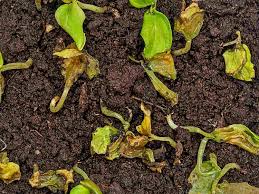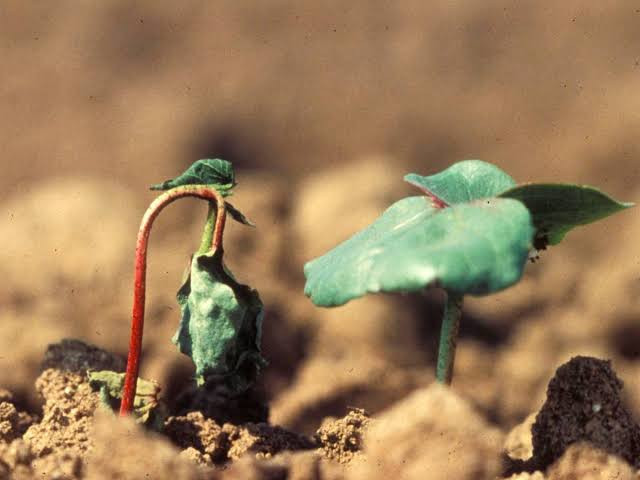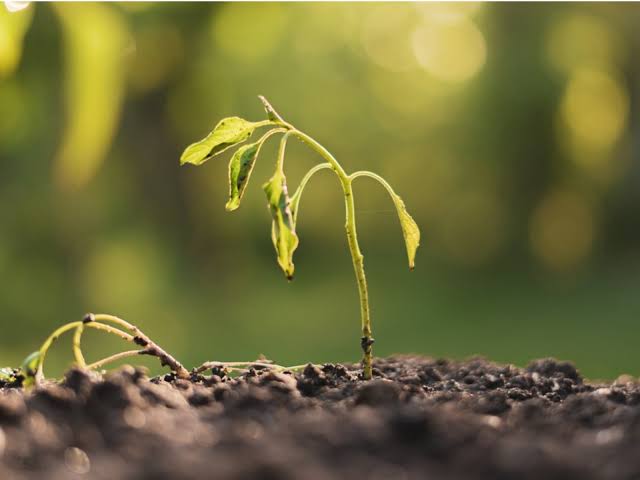Damping-off, scientifically known as Rhizoctonia solani, is a plant disease that affects seedlings, causing them to wilt and collapse. This fungal infection primarily targets the lower stems of young plants, disrupting their growth and often leading to their demise.
In its simplest terms, damping-off is like a sneaky thief in the garden, silently attacking vulnerable seedlings as they embark on their journey to becoming robust plants. The culprit behind this ailment is the Rhizoctonia solani fungus, a microscopic troublemaker that thrives in damp and cool soil conditions.
Picture a baby plant eagerly emerging from the soil, full of potential and dreams of reaching the sun. Now, imagine this tiny green hopeful facing an invisible enemy beneath the surface. Rhizoctonia solani strikes when the soil is too wet, creating a breeding ground for its spores. The fungus then infiltrates the base of the tender stem, encircling it with a sinister embrace.
As the infection progresses, the affected seedlings display visible signs of distress. They start to droop and lose their vitality, resembling a wilted bouquet longing for water. It’s as if the life force within them is being sapped away, leaving behind a sad reminder of what could have been.
Gardeners often encounter damping-off in the early stages of cultivation, when seedlings are at their most delicate. The infection disrupts the delicate balance of life, interrupting the natural course of growth and development. It’s a challenge that even the most experienced gardeners face, as damping-off doesn’t discriminate based on skill level.
To prevent this menace, gardeners must exercise caution with watering practices. Overwatering creates the perfect environment for Rhizoctonia solani to thrive, so finding that delicate equilibrium is crucial. Additionally, providing proper ventilation and spacing between seedlings can help mitigate the risk of infection.
However, damping-off, or Rhizoctonia solani, is a formidable adversary for young plants, disrupting their growth and stealing away the promise of a bountiful harvest. Vigilance in watering practices and creating an environment that discourages fungal growth are essential steps in protecting seedlings from this silent assailant. It’s a battle waged beneath the soil’s surface, where the fate of a tiny seedling hangs in the balance, waiting to either flourish or succumb to the insidious effects of damping-off.
Read Also: Health and Lifespan of Spiders
Plants Affected by Damping-off (Rhizoctonia solani)

Damping-off affects a wide range of plants, particularly those in their early stages of growth. Common victims of this fungal menace include various vegetables, herbs, and ornamental flowers. Seedlings of tomatoes, peppers, lettuce, and cucumbers are among the favorites on Rhizoctonia solani’s menu.
Imagine a row of delicate tomato seedlings, each with the potential to bear plump, juicy fruits. Damping-off, however, poses a threat to this potential harvest, causing these young plants to wither and collapse before they can reach maturity. The same story unfolds for peppers, where the vibrant green leaves of promising plants succumb to the unseen attack beneath the soil.
It’s not just the vegetable garden that falls prey to damping-off; herbs like basil and cilantro also face the risk of stunted growth and demise. The fragrant leaves of these aromatic herbs may seem resilient, but their tender stems are susceptible to the insidious invasion of Rhizoctonia solani.
Even ornamental flowers, with their vibrant colors and delicate petals, are not spared from the clutches of damping-off. Seedlings of marigolds, petunias, and zinnias can fall victim to the fungus, thwarting the aspirations of creating a beautiful, blooming garden.
In essence, damping-off is an equal-opportunity adversary, affecting a diverse array of plants that share the vulnerability of being in their early stages of development. Whether you’re nurturing a vegetable garden or cultivating a bed of flowers, the threat of damping-off looms, underscoring the importance of proactive measures to protect the potential of these young plants.
Damages Caused by Damping-off

Damping-off wreaks havoc on plants by causing a range of damages that hinder their growth and development. This insidious fungal disease inflicts harm in various ways, creating setbacks for gardeners and threatening the success of a planting endeavor.
First and foremost, damping-off strikes at the very foundation of a plant’s future—the seedlings. By infecting the base of the stem, the fungus compromises the structural integrity of the young plant. This leads to a visible wilting and collapse of the seedling, effectively cutting short its journey to becoming a mature, productive plant.
Moreover, the damage caused by damping-off extends beyond the immediate loss of individual seedlings. As the disease progresses, it can result in poor stand establishment, meaning that fewer plants successfully grow to maturity. This reduction in overall plant population has a cascading effect, diminishing the yield and potentially impacting the intended purpose of the planting, whether it be for food production or ornamental display.
Damping-off also disrupts the delicate balance of a garden ecosystem. As the fungus thrives in damp and cool conditions, it can persist in the soil, creating an environment unfavorable for healthy plant growth. This persistence makes it challenging for gardeners to cultivate a thriving garden, as the lingering threat of damping-off looms over subsequent planting cycles.
Furthermore, the economic implications of damping-off should not be overlooked. For commercial growers, the loss of a significant number of seedlings translates into decreased productivity and potential financial setbacks. The investment of time, resources, and effort in nurturing a crop or ornamental plants may be compromised by the destructive force of Rhizoctonia solani.
However, damping-off inflicts substantial damages by compromising the integrity of seedlings, reducing stand establishment, disrupting garden ecosystems, and imposing economic burdens on growers. Its effects are far-reaching, emphasizing the importance of preventive measures to safeguard the potential of plants and ensure a successful and fruitful growing season.
Read Also: The Appearance and Features of Rat Snakes
Control and Preventive Measures

Controlling and preventing damping-off involves adopting strategic measures to mitigate the risk of Rhizoctonia solani and create conditions unfavorable for its growth. These practices are crucial for safeguarding young plants and promoting a healthy garden or crop. Here are some effective control and preventive measures:
1. Well-Drained Soil: Ensure proper drainage in the planting area to prevent excessive moisture, as Rhizoctonia solani thrives in damp conditions. Well-drained soil helps maintain a balance, reducing the risk of fungal growth.
2. Moderate Watering: Practice moderation when watering seedlings. Avoid overwatering, as it creates a conducive environment for damping-off. Watering in the morning allows excess moisture to evaporate during the day, reducing the risk of fungal infection.
3. Proper Ventilation: Enhance air circulation around seedlings by providing proper spacing. Good ventilation helps to minimize humidity levels and discourage the development of Rhizoctonia solani.
4. Sterile Seed Starting Mix: Use a sterile seed starting mix to sow seeds. This minimizes the introduction of fungal spores that may be present in non-sterile soil, reducing the risk of damping-off.
5. Clean Tools and Containers: Sterilize gardening tools and containers before use to prevent the spread of fungal spores. Cleanliness is a simple yet effective measure in preventing the transmission of diseases.
6. Fungicide Treatment: Apply fungicides that are specifically formulated to combat damping-off. Treat seeds or seedlings as a preventive measure, following recommended application rates and guidelines.
7. Temperature Management: Maintain optimal temperature conditions for seed germination. Avoid extremes, as both excessively low and high temperatures can contribute to the development of damping-off.
8. Avoid Overcrowding: Plant seeds at the recommended spacing to prevent overcrowding. Crowded conditions create a microenvironment conducive to fungal growth and the spread of damping-off.
9. Crop Rotation: Practice crop rotation in your garden. Avoid planting susceptible crops in the same location year after year, as this helps disrupt the life cycle of pathogens like Rhizoctonia solani.
10. Biological Controls: Explore the use of beneficial microorganisms, like certain bacteria and fungi, that can act as natural antagonists to Rhizoctonia solani. These biological controls can help suppress the growth of the damping-off-causing fungus.
However, a combination of proper cultural practices, hygiene, and targeted treatments forms a comprehensive approach to control and prevent damping-off. By being proactive and implementing these measures, gardeners can create an environment that fosters the healthy development of seedlings while minimizing the threat of this detrimental fungal disease.
Frequently Asked Questions (FAQs) About Damping-off (Rhizoctonia solani)
Q1: What is damping-off, and how does it affect plants?
A1: Damping-off is a plant disease caused by the fungus Rhizoctonia solani. It primarily affects seedlings, causing them to wilt and collapse. The fungus attacks the lower stems of young plants, disrupting their growth and potentially leading to their death.
Q2: Which plants are most susceptible to damping-off?
A2: Various plants can fall victim to damping-off, especially in their early stages of growth. Common targets include vegetables like tomatoes, peppers, lettuce, and cucumbers, as well as herbs like basil and cilantro. Ornamental flowers, including marigolds, petunias, and zinnias, are also susceptible.
Q3: How can I identify damping-off in my plants?
A3: Visible symptoms of damping-off include wilting and collapsing of seedlings at the soil level. The base of the stem may appear water-soaked, and the affected seedlings often exhibit a lack of vigor. Inspection of the roots may reveal decay and discoloration.
Q4: What are the key factors contributing to damping-off?
A4: Excessive moisture, poor drainage, overwatering, and cool, damp conditions are conducive to damping-off. The fungus Rhizoctonia solani thrives in such environments, making proper soil management and watering practices crucial in preventing its development.
Q5: How can I prevent damping-off in my garden?
A5: Preventive measures include using well-drained soil, practicing moderate watering, ensuring proper ventilation, employing sterile seed starting mix, cleaning tools and containers, applying fungicides, managing temperature conditions, avoiding overcrowding, and considering biological controls.
Q6: Can damping-off be treated once it’s identified?
A6: While there is no cure for damping-off once it has infected a plant, prompt action can help minimize its impact. Removing affected seedlings, improving soil drainage, and adjusting watering practices can limit further spread. Fungicides may also be applied, although prevention remains the primary focus.
Q7: Is damping-off a seasonal issue, and when is it most likely to occur?
A7: Damping-off can occur throughout the growing season, but it is more prevalent in cool and damp conditions. Early spring, with fluctuating temperatures and high humidity, is often a critical period. Proper precautions should be taken during seed germination and early growth stages.
Q8: Can damping-off affect mature plants, or is it limited to seedlings?
A8: Damping-off primarily affects seedlings, especially in their early stages. Mature plants are generally more resistant to the disease. However, weakened or stressed mature plants may still be susceptible to other soil-borne diseases.
Q9: Are there organic methods to control damping-off?
A9: Yes, organic methods include improving soil health through composting, using organic fungicides, promoting beneficial microorganisms in the soil, and practicing good crop rotation. These methods focus on creating a balanced and natural environment that discourages the growth of Rhizoctonia solani.
Q10: Can damping-off be transmitted between different plant species?
A10: While Rhizoctonia solani can affect various plant species, its host range is not unlimited. The fungus may exhibit specificity towards certain plants. Practicing proper hygiene, including sterilizing tools and containers, can help prevent cross-species transmission.
Read Also: The Ultimate Guide to Choosing the Right Garbage Disposal Method
